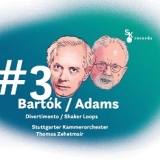Thomas Zehetmair kehrt mit dem Stuttgarter Kammerorchester zu Bartoks Divertimento zurück, das er schon 1999 mit der Camerata Bern für ECM aufgenommen hatte.
Wenn er damals die gegensätzlichen Stimmungen und Gefühle radikal betont hatte, so gelingt ihm das diesmal genauso gut und zusätzlich vielleicht noch mit etwas mehr Raffinement. Auch in dieser Aufnahme spüren wir die sengende Hitze oder auch die erfrierende Kälte. Dem zweiten Satz gibt Zehetmair einen total irrealen Charakter, als sei die Musik nicht mehr aus dieser Welt.
Die Wirkung des Finalsatzes könnte nach so viel düsterer Trauer nicht stärker ein: Der Satz mit seinen volksmusikalischen Wurzeln bekommt bei Zehetmair motorische Rhythmik, die mit der das Ohr schmeichelnden Kadenz von Solobratsche und Sologeige kontrastiert, ehe die Musik dann flatterhaft und kraftvoll dem Ende zustrebt.
Mit den Sätzen Shaking and Trembling, Hymning Slews, Loops and Verses und A Final Shaking ist Shaker Loops von John Adams ein in erster Linie rhythmisches Werk, mit dem uns das Stuttgarter Kammerorchester im ersten Satz auf einem Parforce-Ritt gehörig durchschüttelt.
Mit seinen quietschenden Klängen könnte der zweite Satz das musikalische Bild einer dieser Ghost Towns im Westen der USA sein.
Der dritte Satz ist anfangs sehr melancholisch, wird dann immer rhythmischer und zittriger, am Schluss auch stampfend, damit wohl an die Skaker-Tänze erinnernd, die Adams in seiner Kindheit sah. Der vierte Satz ist wiederum rhythmisch drängend. Die fein differenzierte Interpretation macht dieses Stück bei allem Minimalismus sehr aufregend.
Thomas Zehetmair returns with the Stuttgart Chamber Orchestra to Bartok’s Divertimento, which he had already recorded with the Camerata Bern for ECM in 1999.
If he had radically emphasized the contrasting moods and emotions then, he succeeds just as well this time, and in addition perhaps with a little more refinement. In this recording, too, we feel the scorching heat or even the freezing cold. Zehetmair gives the second movement a totally unreal character, as if the music were no longer of this world.
The effect of the final movement could not be stronger after so much gloomy sadness: The movement, with its folk-music roots, is given motoric rhythms by Zehetmair, contrasting with the ear-flattering cadence of solo viola and violin, before the music then flutters powerfully toward its conclusion.
With the movements Shaking and Trembling, Hymning Slews, Loops and Verses and A Final Shaking, Shaker Loops by John Adams is primarily a rhythmic work, with which the Stuttgart Chamber Orchestra shakes us up in the first movement on a par force ride.
With its squealing sounds, the second movement could be the musical image of one of these Ghost Towns in the west of the USA.
The third movement is initially very melancholy, then becomes increasingly rhythmic and tremulous, at the end also stomping, thus probably reminiscent of the Skaker dances that Adams saw in his childhood. The fourth movement is again rhythmically urgent. The finely differentiated interpretation makes this piece, for all its minimalism, very exciting.






















